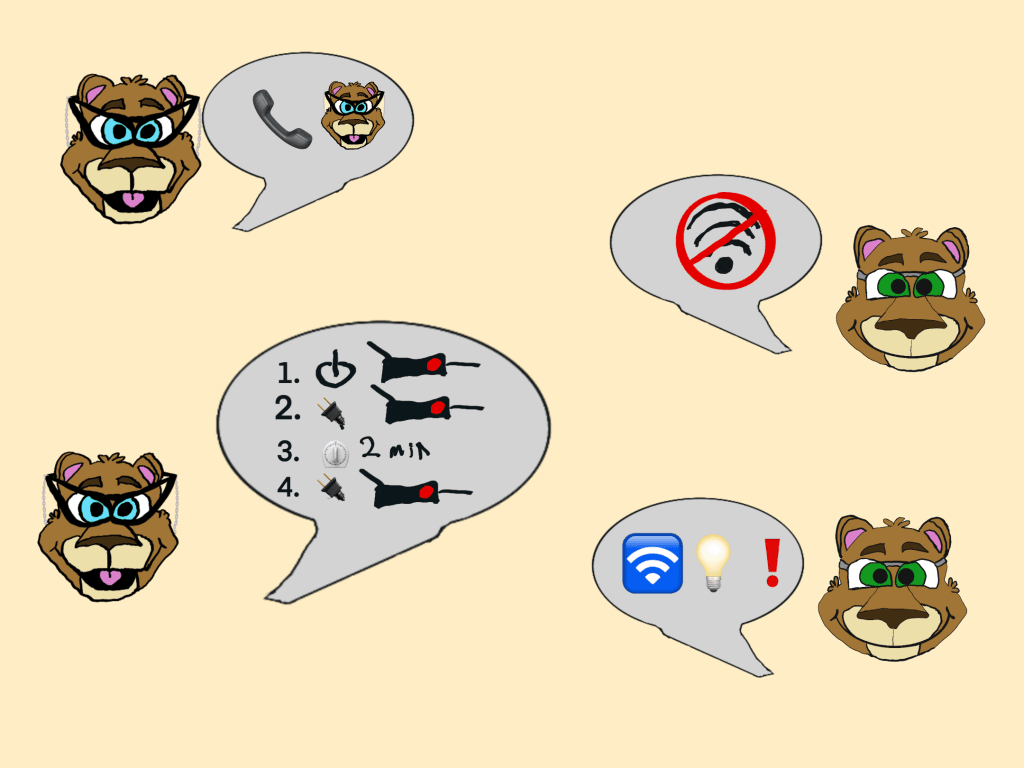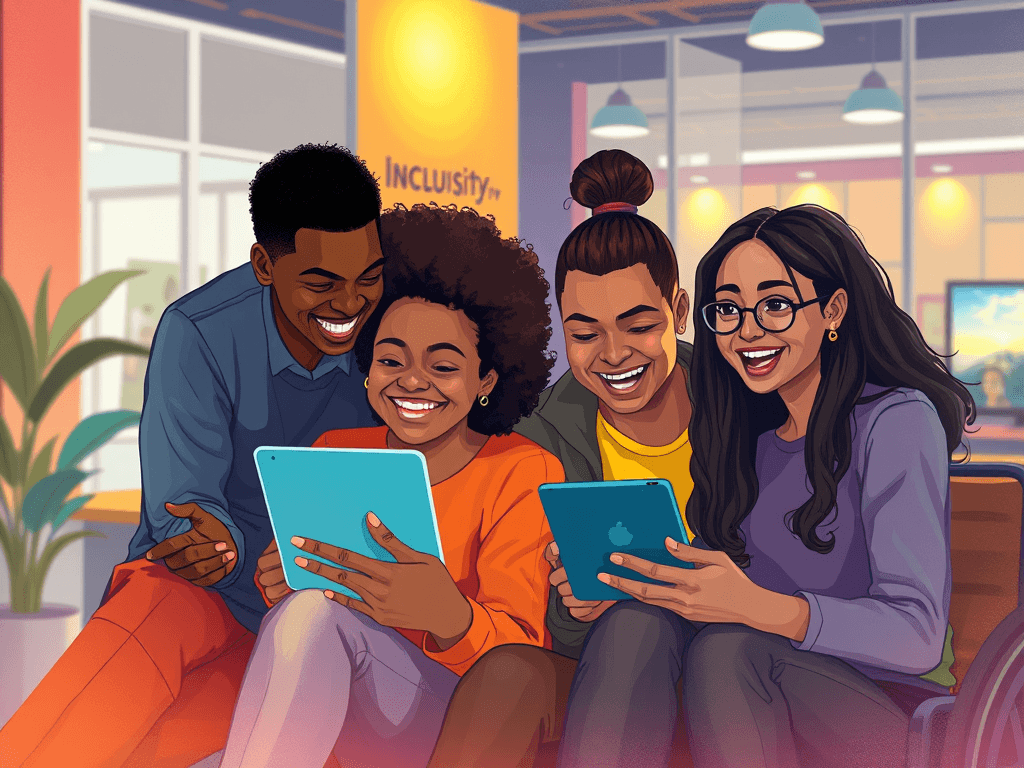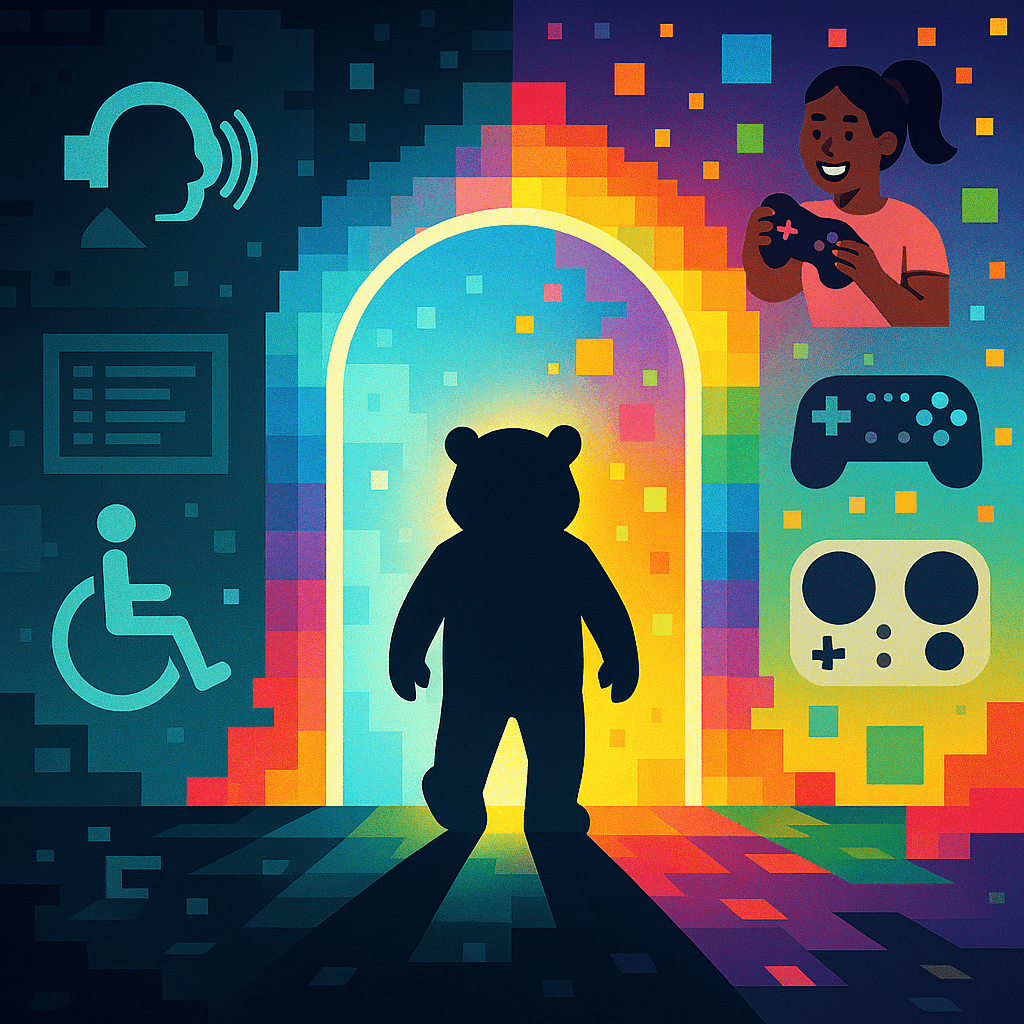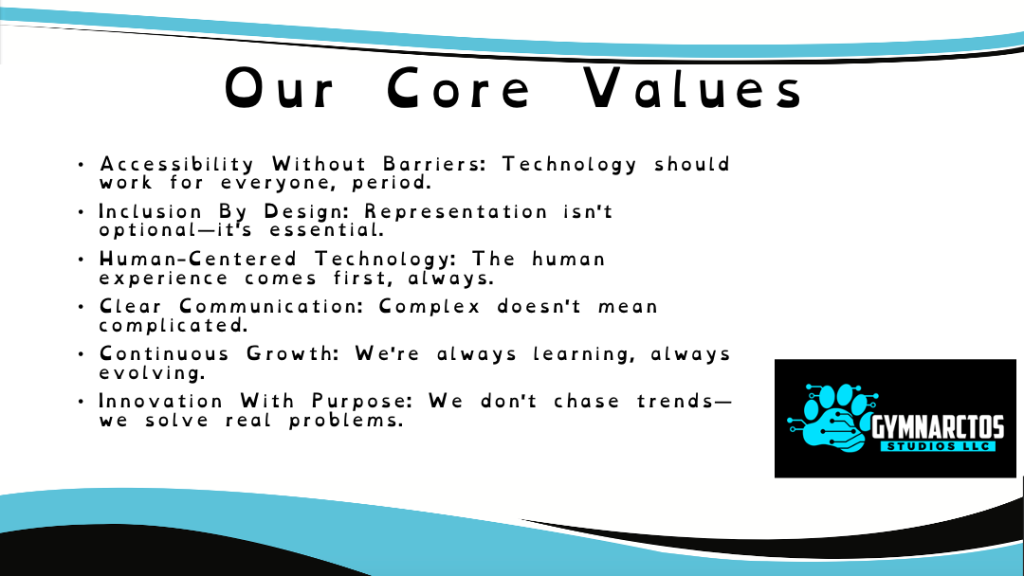Clear Communication in Tech: Complex Doesn’t Mean Complicated

Editor’s note: This blog post refers to some additional content that Gymnarctos Studios has not yet produced, including audio and video clips, as well as the ‘cheat sheet’. When those resources are ready, we will update the post. Technology often uses big words and hard-to-understand terms. This creates walls that keep people out. At Gymnarctos Studios, we believe clear communication in tech is not just a bonus—it’s a must. Our fourth core value is “Clear Communication: Complex doesn’t mean complicated.” This shows how much we care about making sure everyone can access and understand our products. Why Clear Communication in Tech Matters Let’s start with an example situation. A customer calls Gymnarctos Studios with a technical problem. Here, their Wi-Fi is down. Technology should be for everyone, not just people who know special tech words. Clear communication in tech breaks down walls and makes new ideas open to all. Here is what happens when we DON’t use clear communication. When we talk and write clearly: AUDIO VERSION: Listen to this section here Research shows that clear communication helps more people use new technology. The number of users can go up by 135%! This is not just right—it also helps business grow. VIDEO TIP: Watch our 2-minute explanation on why clear communication matters here Making Things Simple Without Making Them Too Simple Clear communication in tech doesn’t mean making things too basic. It means finding a good balance. We need to be correct but also easy to understand. Here’s how we do this at Gymnarctos Studios: Pictures Help People Understand The pictures help the customer understand. In this image, Techbear explains how to reset the router. This is an example of the clear communication style we use. When we explain hard ideas, we use pictures along with words. Studies show our brains process pictures 60,000 times faster than words. We use: These visual tools help with our talking and writing. They make sure hard ideas don’t stop people from understanding. Writing That Real People Can Understand Our writing team follows these clear communication in tech rules: TRY IT YOURSELF: Download our Clear Writing Checklist Research shows that easier-to-read content makes users happier. When reading ease goes up by 10%, user happiness goes up by 7.9%. How We Use Clear Communication Every Day Clear communication in tech is not just talk—we do it every day at Gymnarctos Studios: Making Screens Easy to Use Our design team makes screens that explain themselves. We follow ideas from experts like Don Norman in his book “The Design of Everyday Things”: INTERACTIVE DEMO: Try our interface simplicity test to see these principles in action Support Team That Really Helps Our support team shows clear communication in tech by: AUDIO EXAMPLE: Listen to a sample support call showing our communication style How Clear Communication Helps Our Business Spending time on clear communication in tech helps our whole company: Image description: Simple bar chart showing improvements in support tickets, onboarding, satisfaction scores, and user diversity Studies show that companies that focus on clarity keep more customers. They do about 18% better than other companies. VIDEO: Watch our 1-minute explanation of how clear communication helped our business grow Tools We Use For Clear Communication We use these tools to keep our clear communication in tech strong: TRY IT YOURSELF: Check your own writing with this free readability tool Join Us In Making Tech Talk Clearer We at Gymnarctos Studios want you to join us in making clear communication in tech a priority. Whether you use our products, work with us, or make your own tech, let’s make tech talk better for everyone. Quick Summary (TL;DR) DOWNLOAD: Get our Clear Communication Cheat Sheet (PDF, 2 pages) Learn More About Clear Communication Want to learn more? Try these resources: ASK US: Have questions about clear communication? Watch our FAQ video What’s your experience with clear communication in technology? Tell us in the comments below! This post is part of our Thoughtful Thursday series about Gymnarctos Studios’ core values. Next week we’ll look at “Continuous Growth: We’re always learning, always evolving.” AUDIO VERSION: Listen to the full blog post here
Thoughtful Thursday: Core Value # 3 Human-Centered Technology – Putting People Before Pixels

Gymnarctos Studios emphasizes the importance of human-centered technology, which prioritizes user needs and experiences. By focusing on real human input, simplifying designs, and ensuring accessibility, the studio aims to create intuitive technological solutions that enhance user satisfaction and promote inclusivity. Their philosophy is rooted in making technology a supportive companion in everyday life.
10 Brilliant Ways to Create Effective Task Reminders That You Won’t Ignore: The Techbear Guide to Actually Getting Stuff Done

Listen up, productivity wannabes. Creating effective task reminders is the difference between actually getting things done and drowning in a sea of forgotten obligations. If your current reminder system consists of 47 sticky notes slowly peeling off your monitor and a vague sense of impending doom, this one’s for you. Today we’re diving into the world of effective task reminders that actually remind you of things instead of becoming digital clutter you’ve mastered the art of ignoring. Why Your Current Reminder System Is Failing Miserably Let’s be honest—if your phone is constantly buzzing with notifications you immediately swipe away without reading, you might as well just throw your device into the nearest body of water. It would be equally effective and more dramatic. The average human attention span is now shorter than a goldfish’s, which explains why you’ve probably forgotten what this article is about three times already. Welcome back, by the way. Way #1: Make Your Reminders Ridiculously Specific Setting effective task reminders starts with specificity. “Follow up” is not a reminder. It’s a wish upon a star. Try something radical like “Email Sarah about Q2 report corrections by 2 PM Tuesday” instead. Research shows that implementation intentions (the fancy term for specific when-then plans) make you 2-3 times more likely to actually do the thing. The formula for a specific reminder is brutally simple: What + When + Where + How. If your reminder doesn’t answer these questions, it’s about as useful as a chocolate teapot. Further Reading: The Science of Implementation Intentions Way #2: Harness the Power of Location-Based Triggers Your brain isn’t wired to remember random tasks at random times—it’s wired to remember contextual cues. That’s why you walk into the kitchen and immediately forget why you went there. Setting up location-based reminders that ping you when you arrive at specific places is basically outsourcing your memory to robots. “Remind me to pick up printer paper when I’m near Office Depot” is significantly more useful than “buy paper sometime maybe.” Pro tip: Set exit reminders too. “Don’t forget your umbrella when leaving the office” has saved countless technocubbies from getting drenched because their predictably forgetful brains were too busy thinking about happy hour. Further Reading: How Geofencing Makes Reminders Actually Work Way #3: Schedule Reminders When Your Brain Actually Works Creating effective task reminders means timing them properly. Scheduling a reminder to “start that massive project” at 4:45 PM on a Friday is self-sabotage at its finest. According to research on biological prime time, most humans have peak focus periods in the late morning and late afternoon. Schedule your most brain-intensive reminders accordingly, or accept your fate as an eternal procrastinator. Map your energy levels for a week (yes, an actual week, not just your theoretical best day) and schedule reminders to tackle complex tasks during your high-energy windows. Save your low-energy periods for reminders about mindless tasks like “organize your digital sock drawer” or “like your boss’s cringey LinkedIn posts.” Further Reading: When: The Scientific Secrets of Perfect Timing Way #4: Transform Your Phone’s Default Reminder App Let’s talk about the elephant in the room: your phone’s built-in reminder app probably sucks. But with a few tweaks, you can make those default phone reminders actually useful. The key to effective task reminders on your phone is customization. Use different alert sounds for different priority levels. Set recurring reminders for habits you’re building. And for heaven’s sake, turn on badge notifications instead of relying on those easily-dismissed banners that you’ll ignore faster than emails from your college alumni association. For iPhone users: Did you know you can set reminders based on when you message someone? “Remind me about the project deadline next time I text Dave” is the passive-aggressive productivity hack you didn’t know you needed. For Android users: Smart reminders that bundle with related apps (like Grocery reminders showing up when you open your grocery list app) are a game-changer for context-switching disasters like your brain. Further Reading: Hidden Features in iOS Reminders | Google Keep’s Secret Power Features Way #5: Use the Two-Minute Rule to Avoid Reminder Overload Here’s the dirty little secret reminder apps don’t want you to know: the best reminder system is the one you’ll actually use consistently. Groundbreaking, I know. If you’re constantly ignoring your reminders, try the two-minute rule: If a task takes less than two minutes, do it immediately instead of setting a reminder. For everything else, create effective task reminders that pass what I call the “Future You Test”—would your tired, annoyed future self actually understand and appreciate this reminder, or will they hate Past You for being vague and unhelpful? Your reminder app should not be a graveyard for tasks you’re avoiding. It should be a trusted system that helps you, not a digital representation of your mounting anxiety. Further Reading: Getting Things Done: The Art of Stress-Free Productivity Way #6: Apply the “Future You Test” for Every Reminder Ever set a reminder that says “Important thing!!!” only to have no clue what that important thing was when it pops up? Congratulations, you’ve failed the Future You Test. Creating effective task reminders means considering your future mental state. Future You will have forgotten the context, the urgency, and probably what day it is. Future You is basically a confused golden retriever wearing your clothes. Include enough context that Future You doesn’t curse Past You’s name. Add links to relevant files, include phone numbers you’ll need, specify exactly which “John” you’re supposed to call (Work John? Neighbor John? John who owes you money?). Better yet, write reminders with empathy for your future self: “Call insurance – have policy number ready (in Notes app), call before 5pm EST, estimated call time: 15 min, reward self with cookie afterward.” Further Reading: The Present Bias: Why Your Future Self Doesn’t Stand a Chance Way #7: Master the Art of Priority Coding Not all reminders are created equal. “Buy milk” and “Submit tax documents before audit deadline” probably shouldn’t have
Thoughtful Thursday: Inclusion By Design – 4 Powerful Ways to Ensure Everyone Matters

Gymnarctos Studios promotes “Inclusion by Design,” a philosophy ensuring technology welcomes and reflects diverse identities and experiences. This approach embeds inclusion into every design process, addressing barriers to accessibility and representation. By valuing diverse perspectives, the studio aims to create engaging, empathetic experiences for all users, making technology a space where everyone belongs.
Accessibility in Technology: Breaking Barriers for Inclusive Gaming and Design

Technology should be a bridge, not a wall. Yet for too long, the software development and gaming industries have treated diversity as an afterthought—if they’ve considered it at all. At Gymnarctos Studios, we believe that truly innovative technology must work for everyone, regardless of body, gender, ability, sexual orientation, or background. In today’s digital landscape, the significance of accessibility and representation in technology and gaming cannot be overstated. Every day, millions of individuals interact with technology, and for many, the ability to do so hinges on the design choices made by developers and designers. When technology is built with accessibility in mind, it not only enhances user experience but also fosters a sense of belonging among all users. As we dive deeper into this subject, it is critical to understand the broader implications of excluding diverse voices in tech and gaming. The Current Landscape: A Story of Exclusion The repercussions of exclusion reach far beyond individual frustration; they affect entire communities. When products fail to accommodate diverse needs, they perpetuate a cycle of marginalization. For instance, consider the realm of online gaming. Players with disabilities may find themselves sidelined, unable to engage fully in communities that could otherwise enrich their lives. This lack of representation in both games and the industry creates a narrative that some individuals are less worthy of equitable access and enjoyment. To truly understand the landscape of accessibility, we must look at real-world examples of successful implementations. Companies that prioritize accessibility often see not only increased user satisfaction but also a surge in customer loyalty. For instance, the success of platforms like Apple and their commitment to accessibility features such as VoiceOver illustrates how a focus on inclusivity can lead to market dominance. By integrating accessibility into their fundamental design philosophy, these companies demonstrate that it is not merely a compliance issue but a business imperative. Moreover, the notion of accessibility extends beyond traditional definitions. It encompasses the experiences of all users, including those who may not have disabilities but face barriers to engagement due to socio-economic factors or technology literacy. By considering these additional dimensions, tech companies can create a more inclusive environment that fosters diversity and innovation. The statistics are stark. Roughly 96% of websites fail basic web accessibility guidelines, effectively shutting out millions of users with disabilities. In gaming, representation has been even more dismal—LGBTQ+ characters are often reduced to minor side quests, if they exist at all. This isn’t just a missed opportunity; it’s a fundamental failure of design. Accessibility: More Than a Checkbox Accessibility isn’t about meeting minimum requirements. It’s about creating experiences that are genuinely inclusive from the ground up. For users with disabilities, accessible technology isn’t a nice-to-have—it’s essential for full participation in digital life. This means: Representation: Seeing Yourself in the Digital World Representation goes beyond tokenism. It’s about creating narratives and characters that reflect the rich diversity of human experience. In gaming, this means: Representation in gaming can take many forms, from character design to narrative arcs. Authentic representation means understanding and portraying characters that reflect genuine experiences and backgrounds. For instance, the groundbreaking success of games like ‘The Last of Us Part II’ showcases a rich tapestry of characters that challenge stereotypes, allowing players from various backgrounds to see themselves in the stories being told. This approach not only enhances gameplay but also contributes to a more nuanced understanding of different cultures and identities. Why Diversity Matters in Tech Diverse teams create better technology. When developers come from varied backgrounds, they: Our Commitment At Gymnarctos Studios, diversity isn’t a marketing strategy—it’s our core philosophy. We’re building technology and games that: In addition to better technology outcomes, diversity in tech leads to more sustainable and ethical product development. Teams comprising diverse individuals bring unique insights that can significantly influence product direction, ensuring that potential pitfalls are recognized early in the process. For example, a diverse team might identify an overlooked accessibility feature that could be crucial for a specific demographic, thereby creating a product that resonates on a deeper level with its users. The future of technology isn’t about building for the majority. It’s about creating spaces where everyone belongs. Join the Movement Accessibility and representation aren’t just ethical imperatives—they’re the foundation of truly innovative technology. Whether you’re a developer, a gamer, or simply someone who believes in inclusive design, you can help drive this change. Together, we can build a digital world that doesn’t just accommodate diversity—but celebrates it. Our commitment at Gymnarctos Studios is not just to develop accessible and inclusive technology, but to actively engage with our community to create dialogue around these issues. We host workshops and discussions that encourage feedback from users across the spectrum, ensuring that we remain grounded in reality and responsive to the needs of those we serve. By fostering an open line of communication, we not only improve our products but also contribute to a culture of inclusivity in the tech landscape. #AccessibilityMatters #InclusiveTech #DiversityInGaming #RepresentationCounts #TechForAll #GameDevelopment #DigitalInclusion #EqualityInTech #AccessibleDesign #LGBTQGaming Ultimately, the call to action is for everyone involved in technology and gaming to recognize their role in advocating for change. Engaging with these principles creates a ripple effect that can lead to broader societal shifts. Whether through advocating for better policies, supporting diverse creators, or simply educating oneself about the importance of accessibility, every effort counts. As we move forward, let us collectively strive to build a digital world that not only accommodates diversity but thrives because of it. By embracing and prioritizing accessibility and representation, we can create technology that truly serves everyone. The future is not just for a select few; it belongs to all of us. Quoted Statistics come from https://glaad.org/releases/glaads-inaugural-glaad-gaming-report-finds-growing-number-of-lgbtq-gamers/And https://ablegamers.org/how-the-gaming-industry-is-adapting/ Some numbers are estimated as I could not find authoritative statistics(no one has done the research yet.)
Values Wednesday: Building Better Tech with Our 6 Guiding Principles at Gymnarctos Studios

Welcome to our first Values Wednesday! 🌟 This marks the start of a weekly series where we explore the six guiding principles that shape everything we do at Gymnarctos Studios. These aren’t just lofty ideals—we live and breathe them in every line of code, every user experience, and every game mechanic we design. Whether you’re a client, a collaborator, or a curious visitor, we invite you to learn more about what drives us. Understanding a company’s core beliefs gives you a deeper look into how it thinks, works, and connects with the world. Why Core Beliefs Matter in Tech and Design In the fast-paced world of technology, it’s easy to focus solely on tools, trends, and deliverables. But at Gymnarctos Studios, we believe that grounding our work in a strong set of core tenets is what truly sets us apart. These fundamentals are our north star—they guide how we build, how we collaborate, and how we grow. Technology should not be a cold, impersonal system. It should be an extension of our human needs and imagination. Our guiding stars help us create digital experiences that are not just functional, but meaningful. A Sneak Peek at Our Core Principles Over the next several Wednesdays, we’ll be shining a spotlight on each of our six core values, one by one. Here’s a brief look at the principles that define our studio: Each of these principles informs not only how we work, but why we work the way we do. These are the foundations that inspire us to deliver high-quality, inclusive, and impactful digital experiences. What to Expect in the Coming Weeks Each upcoming Values Wednesday post will go deeper into one of these six core ideas, exploring its meaning, how we apply it, and why it matters in today’s tech landscape. We’ll include real-life stories, lessons learned from projects, and even a few behind-the-scenes moments that illustrate how our company ethos shows up in our daily work. Whether we’re debugging a tricky web app, designing a UI for neurodivergent users, or building out a narrative in one of our games, you’ll see how our fundamental beliefs are at the heart of everything we do. Additional Reading WCAG 2.1 Accessibility Guidelines Microsoft Inclusive Design Hub GLAAAD.org’s Inaugural Gaming Report Join the Conversation This isn’t just about us—it’s about community. We’d love to hear how you see these core tenets influencing your own work, industry, or personal life. What principles drive you? Which of these six resonates the most with your experience? Comment below, connect with us on social media, or share this post with someone who believes in building better technology through shared values. Let’s keep the conversation going. Why It All Comes Back to Our Core At the end of the day, these aren’t just words—they’re commitments. They help us choose the right projects, the right clients, and the right collaborators. They shape our creative direction and our business strategy. Most importantly, they keep us accountable to ourselves and to our community. Thanks for being here at the start of this new series. Stay tuned for next week’s deep dive into Accessibility Without Barriers—and find out how we’re rethinking access in everything we build. Stay curious, stay grounded, and stay connected. 💻✨ #ValuesWednesday #CoreValues #InclusiveDesign #AccessibleTech #TechWithPurpose #LGBTQIA #GameDevStudio #DigitalEthics #SmallBusinessIT #GymnarctosStudios
